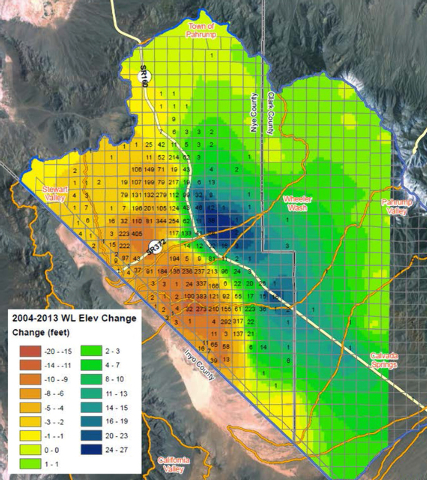Report: Pahrump aquifer trends 10-year decline
Aquifer levels are decreasing in areas where domestic wells are clustered, according to a report.
Nye County staffers presented the results of 10 years of data collection from well level measurement throughout the Pahrump Basin to the Nye County Water District on Monday.
The results, which reflect an overall steady decline of approxmately one to two feet per year in water levels in portions of the Pahrump Basin, were also exhibited at the Nevada National Security Test Site Open House and Advisory Board meeting in Beatty on Feb. 18.
The water measuring program has existed for 15 years and during that time over 12,000 measurements have been taken throughout the valley, according to County Geoscience Manager Levi Kryder.
The collected data, he said, has allowed him to look at trends in water levels over time. That, in turn, he said reflects how groundwater conditions are changing.
A groundwater flow model will be built from the existing and future data. The model can then be used as a tool to help make predictions about future water usage. The model, he said, will be useful for simulating conditions for future planning.
A total of 147 wells were measured as part of the data collection. Thirty-nine of those wells are monitored by the United States Geological Survey and five wells are measurerd by the Nevada Division of Water Resources.
Eleven of the 147 wells were drilled in 2010 with grant funding from the Department of Energy.
County Geoscientist John Klenke said each of the organizations are part of a scientific community that share information about water in the area.
Kryder said the results of the data collection show that water levels are rising in certain parts of the the Pahrump Basin, north of Wheeler Wash through south of Trout Canyon, on the alluvial fan portion of the aquifer.
Contextual information in the mapping is speculative. Kryder indicates that he believes increases in the water levels on the alluvial fan are due to precipitation falling on the Spring Mountains.
Also indicated is the statement that declines in the valley floor basin west into California are the results of contouring and may not represent actual water level changes.
Groundwater models, Kryder said, are only as useful as the data on which they are built. “Each additional assumption used to build the model brings with it additional uncertainty,” he said. It is not disputed that modeling programs are imperfect.
However, based upon the model, Kryder said, “Some level of action is required to reach future development goals without further depleting those (water) resources.”
The Water District began funding the water measuring program last year.















